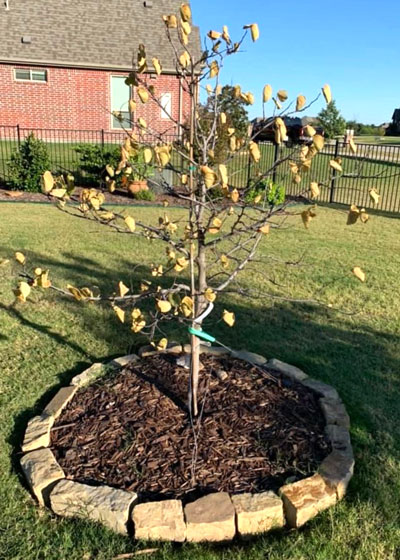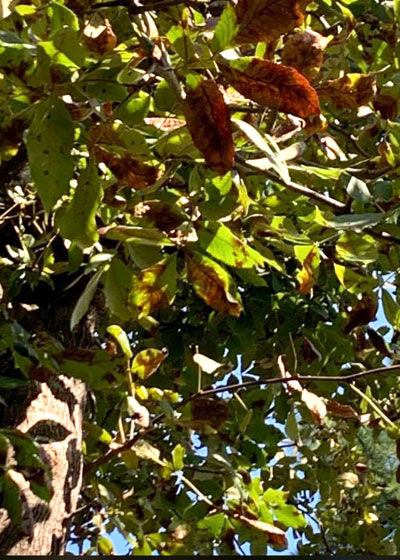Question of the Week – Number 1: October 1, 2020
“I think my shade tree has some kind of fungus. What can I spray to control it?”
I must have been asked variations of this 25 times in the past 10 days. I won’t say that my suggestions given here on the first day of October will fit every case, but they’ll fit 99 percent of your trees.

Redbud
The person who posted this photograph on my Facebook page felt that the tree had some kind of a disease. It’s obviously a very sturdy young redbud, but I see no evidence of any disease on the leaves or anywhere else.
My guess is that this tree was allowed to get too dry one or more times a few weeks before this photograph was taken. I see that happen fairly often, and nothing else gives those symptoms.
Redbuds are rather resilient and tolerant of Texas droughts in their native homes, so hopefully it will leaf out come spring. Other than keeping it moist over the winter, there wasn’t much I could tell her to do.
I will add that raised beds like this tend to shed water away from the root system of a new tree. That can lead to problems exactly like this. They also draw a lot of attention to the trunk of the tree, and I’m not sure that that is visually desirable. If this were my tree I probably would remove the bed and leave a small basin in which I could water the tree for the first year or two.

Hickory
It’s difficult to make out a lot of detail from this very busy photograph posted to my Facebook page a few days ago. However, the description given was typical of one that I hear many times each week. “Neil! My tree has brown edges to its leaves and they’re getting all dried. They’re falling early. I think it has a fungus. What can I do?”
If there is a fungus involved on these leaves, it is one that appeared late in the growing season. These leaves are going to fall within the next few weeks. Spraying is not going to green them up. They’re going to fall anyway.
My recommendation is let that happen. Run your mower over them to collect them in the bag, and then put them in the compost pile to decay completely. Only if you see some kind of a leaf disease early next growing season would you ever want to spray. There is no benefit to treating this late in the season. This applies to other species of trees as well.

Lacebark Elm
Finally we do have a tree that does have a fungal disease. Unfortunately, it’s cotton root rot, and we do not have any means of controlling it. Lacebark elms are highly susceptible. One of its characteristic symptoms is sudden death of afflicted specimens, and there is nothing you can do to stop it or prevent it.
Your best way of dealing with cotton root rot in this sort of situation is to replace the tree with another species of tree – some kind that is highly resistant or immune to the soil-borne-fungus. Most of our oaks, cedar elm, pecans, magnolias and Chinese pistachios would be. Once again, I would probably eliminate the raised planting bed.
